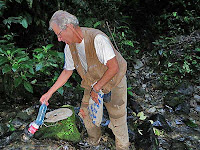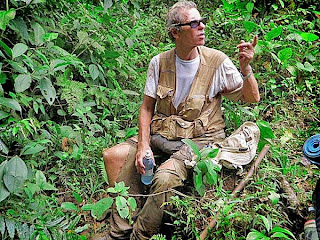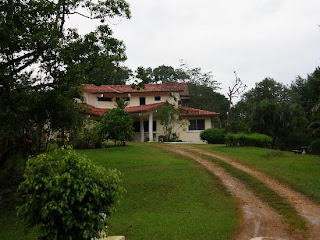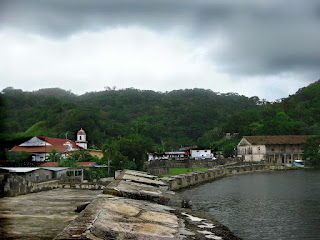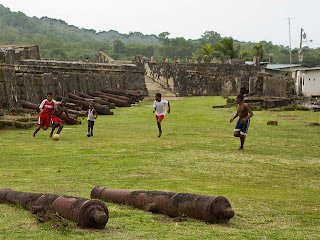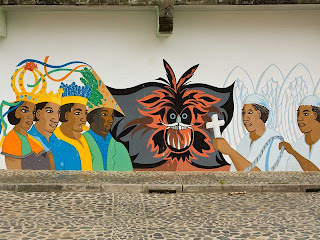
The Festival of the “El Nazareno de Portobelo”, “El Cristo Negro”, or the Black Christ tradition dates back to the 16 century. Celebrated on October 21 each year in the small town of Portobelo in the Province of Colon, Panama. Many of it's residents are Black Panamanians take note this is by no means a blacks only celebration it attracts more than 50,000 each year.
The origins of “El Cristo Negro” as the story by locals tell of three legends.
The box and the storm: A ship bound for Cartagena de Indias, was trying to sail from Portobelo during a violent storm, forcing the ship to return to port. In the fifth attempt to leave the crew was about to sink, so they decided to lighten the load throwing away a huge and heavy box they had housed in their warehouse. Some fishermen found the box and when they opened it they saw the image of El Nazarene, taking it to the village, and placing the statue in the church.
violent storm, forcing the ship to return to port. In the fifth attempt to leave the crew was about to sink, so they decided to lighten the load throwing away a huge and heavy box they had housed in their warehouse. Some fishermen found the box and when they opened it they saw the image of El Nazarene, taking it to the village, and placing the statue in the church.
The case and epidemic: A fisherman found a box floating in the sea during an epidemic of cholera, which decimated the population heavily. The Cristo Negro then was placed inside the church then almost immediately, the epidemic ended and the patients recovered quickly.
 The religious roots that have this devotion in this popular area could be subject to a socio-religious culture and faith of the Panamanian people.
The religious roots that have this devotion in this popular area could be subject to a socio-religious culture and faith of the Panamanian people.
Today this festival takes place in the parish church of La Iglesia San Felipe one of oldest buildings in the town finished in 1814. It also houses the image of El Nazareno de Portobelo, a handsome statue of the Cristo Negro bearing the cross, made of wood from southern Spain more that 300 years ago.
Many walk more than 53 miles from Panama City; thousands walk the last 22 miles from the town of Sabanitas, as I did with friends to experience this tradition. Many crawled the last mile on hands and knees to worship before El Nazareno. I am here to let you know I did not crawl or wear a purple robe.
mile on hands and knees to worship before El Nazareno. I am here to let you know I did not crawl or wear a purple robe.
The origins of “El Cristo Negro” as the story by locals tell of three legends.
The box and the storm: A ship bound for Cartagena de Indias, was trying to sail from Portobelo during a
 violent storm, forcing the ship to return to port. In the fifth attempt to leave the crew was about to sink, so they decided to lighten the load throwing away a huge and heavy box they had housed in their warehouse. Some fishermen found the box and when they opened it they saw the image of El Nazarene, taking it to the village, and placing the statue in the church.
violent storm, forcing the ship to return to port. In the fifth attempt to leave the crew was about to sink, so they decided to lighten the load throwing away a huge and heavy box they had housed in their warehouse. Some fishermen found the box and when they opened it they saw the image of El Nazarene, taking it to the village, and placing the statue in the church.The case and epidemic: A fisherman found a box floating in the sea during an epidemic of cholera, which decimated the population heavily. The Cristo Negro then was placed inside the church then almost immediately, the epidemic ended and the patients recovered quickly.
 The religious roots that have this devotion in this popular area could be subject to a socio-religious culture and faith of the Panamanian people.
The religious roots that have this devotion in this popular area could be subject to a socio-religious culture and faith of the Panamanian people.Today this festival takes place in the parish church of La Iglesia San Felipe one of oldest buildings in the town finished in 1814. It also houses the image of El Nazareno de Portobelo, a handsome statue of the Cristo Negro bearing the cross, made of wood from southern Spain more that 300 years ago.
Many walk more than 53 miles from Panama City; thousands walk the last 22 miles from the town of Sabanitas, as I did with friends to experience this tradition. Many crawled the last
 mile on hands and knees to worship before El Nazareno. I am here to let you know I did not crawl or wear a purple robe.
mile on hands and knees to worship before El Nazareno. I am here to let you know I did not crawl or wear a purple robe. Many wear purple robes that are discarded as they enter the church. The robes announce that the wearer is responding to a divine command, doing penance for wrongdoing, or simply making an expression of faith. They have become the focus of controversy on the part of the Catholic Church and human rights organizations that consider the severe penances or “offerings” that are offered to “The Santo” to be extremely painful and reprehensible in as much as they are self-inflicted. There are also images of the ardent penitents who have a companion drip burning wax over there backs from candles offered to the Black Christ, as a sign of devotion. The crawling pilgrim follows a small effigy of the Black Christ laid down in front of him/her by his companion who encourages the penitents to continue until reaching the church.
As I walked to Portobelo for this event, I noticed Red Cross clinics alongside the road and other first aid groups as well stands offering water and sandwiches to all pilgrims.
stands offering water and sandwiches to all pilgrims.
As one approaches the town of Portobelo it is crowded with families from all over Panama but few tourists were in attendance. The Policia Nacional are there peeking inside purses, backpacks, and frisking men. The women are frisked in a small private makeshift room although senior females are not, they are signaled to continue ahead.
The town is alive with salsa and reggae music playing everywhere; beer and water are sold on the doorsteps of private homes. The atmosphere is alive with the color purple speckling the crowd, many booths sell small statues of the Cristo Negro, purple rosaries and other religious relics. On a small street outdoor barbers line the sidewalk shaving mens hair off for this event while some women choose to have a pedicure. All in preparation for the church service.
many booths sell small statues of the Cristo Negro, purple rosaries and other religious relics. On a small street outdoor barbers line the sidewalk shaving mens hair off for this event while some women choose to have a pedicure. All in preparation for the church service.
Mass begins at 6 p.m. each October 21. (Be there before 4 p.m. if you hope to get inside the church to find a seat.) Most of the penitents sit near the back of the church. Towards the end of mass, there are several very load drum beats and the penitents start dancing, to the drumbeat rhythm and sing. Some men are shirtless, both men and women wave their arms either swaying back and forth on their knees or standing during the chant. At exactly 8 p.m., 80 able-bodied men carry a platform with the statue of the Cristo Negro from the church to begin a four-hour parade around the community the atmosphere is somber.
The bearers take three steps forward, two back, in a similar manner to that of Spanish religious processions. However, unlike those of Spain, this procession has a special Latin American twist: a quick step to lively music. The bearers have freshly shaven heads and have bare feet. It is a distinct honor to bear the Black Christ and to have been chosen, an honor paid for by sore shoulders and aching muscles the next day.
American twist: a quick step to lively music. The bearers have freshly shaven heads and have bare feet. It is a distinct honor to bear the Black Christ and to have been chosen, an honor paid for by sore shoulders and aching muscles the next day.
At exactly midnight, the statue once again is returned to the church until the following year.
The statue of El Cristo Negro wears different robes for two ceremonial occasions each year: red for October 21 and purple for Holy Week, La Semana Santa. Each robe is decorated with lace, gold braid, sequins, and ‘jewels’. Groups of women carefully sew the robes in the economically poor community, using money donated for the purpose.
donated for the purpose.
A museum behind the church holds 63 of the robes donated by Panamanians for the festival, some of which are more than 100 years old. World-famous former boxer, Panama’s own Roberto Duran, donated one of the richest.
The Black Christ wears undergarments of snow-white linen, trimmed with delicate hand-made lace, beneath the outer robe. Worshippers pin gold trinkets and jewelry to the robe on October 21 in the hopes of gaining special privileges. It is truly a most interesting event you may not want to miss while either living in or visiting Panama in October.
Founded in 1597 by Spanish explorer Francisco Velarde y Mercado, Portobelo is a small bay town with a population just over 3000. From the 16th to 18th century, it was an important silver exporting port in New Granada on the Spanish Main and one of the ports on the route of the Spanish treasure fleets. The town was also victim to one of Captain Henry Morgan’s notorious adventures. The forts of Santiago and San Geronimo are each a 5-minute walk from the pier, their historic ruins still stand today, but unfortunately over the years they are slowly deteriorating due to neglect. Located closely to the forts is the "Customs House", built in 1630, also the remains of the church of La Merced still stands today, and the church of San Felipe, the last building built by the Spaniards.
each a 5-minute walk from the pier, their historic ruins still stand today, but unfortunately over the years they are slowly deteriorating due to neglect. Located closely to the forts is the "Customs House", built in 1630, also the remains of the church of La Merced still stands today, and the church of San Felipe, the last building built by the Spaniards.
Read more about Portobelo in Colon on my blog dated May 28, 2010.
As I walked to Portobelo for this event, I noticed Red Cross clinics alongside the road and other first aid groups as well
 stands offering water and sandwiches to all pilgrims.
stands offering water and sandwiches to all pilgrims.As one approaches the town of Portobelo it is crowded with families from all over Panama but few tourists were in attendance. The Policia Nacional are there peeking inside purses, backpacks, and frisking men. The women are frisked in a small private makeshift room although senior females are not, they are signaled to continue ahead.
The town is alive with salsa and reggae music playing everywhere; beer and water are sold on the doorsteps of private homes. The atmosphere is alive with the color purple speckling the crowd,
 many booths sell small statues of the Cristo Negro, purple rosaries and other religious relics. On a small street outdoor barbers line the sidewalk shaving mens hair off for this event while some women choose to have a pedicure. All in preparation for the church service.
many booths sell small statues of the Cristo Negro, purple rosaries and other religious relics. On a small street outdoor barbers line the sidewalk shaving mens hair off for this event while some women choose to have a pedicure. All in preparation for the church service.Mass begins at 6 p.m. each October 21. (Be there before 4 p.m. if you hope to get inside the church to find a seat.) Most of the penitents sit near the back of the church. Towards the end of mass, there are several very load drum beats and the penitents start dancing, to the drumbeat rhythm and sing. Some men are shirtless, both men and women wave their arms either swaying back and forth on their knees or standing during the chant. At exactly 8 p.m., 80 able-bodied men carry a platform with the statue of the Cristo Negro from the church to begin a four-hour parade around the community the atmosphere is somber.
The bearers take three steps forward, two back, in a similar manner to that of Spanish religious processions. However, unlike those of Spain, this procession has a special Latin
 American twist: a quick step to lively music. The bearers have freshly shaven heads and have bare feet. It is a distinct honor to bear the Black Christ and to have been chosen, an honor paid for by sore shoulders and aching muscles the next day.
American twist: a quick step to lively music. The bearers have freshly shaven heads and have bare feet. It is a distinct honor to bear the Black Christ and to have been chosen, an honor paid for by sore shoulders and aching muscles the next day.At exactly midnight, the statue once again is returned to the church until the following year.
The statue of El Cristo Negro wears different robes for two ceremonial occasions each year: red for October 21 and purple for Holy Week, La Semana Santa. Each robe is decorated with lace, gold braid, sequins, and ‘jewels’. Groups of women carefully sew the robes in the economically poor community, using money
 donated for the purpose.
donated for the purpose.A museum behind the church holds 63 of the robes donated by Panamanians for the festival, some of which are more than 100 years old. World-famous former boxer, Panama’s own Roberto Duran, donated one of the richest.
The Black Christ wears undergarments of snow-white linen, trimmed with delicate hand-made lace, beneath the outer robe. Worshippers pin gold trinkets and jewelry to the robe on October 21 in the hopes of gaining special privileges. It is truly a most interesting event you may not want to miss while either living in or visiting Panama in October.
Founded in 1597 by Spanish explorer Francisco Velarde y Mercado, Portobelo is a small bay town with a population just over 3000. From the 16th to 18th century, it was an important silver exporting port in New Granada on the Spanish Main and one of the ports on the route of the Spanish treasure fleets. The town was also victim to one of Captain Henry Morgan’s notorious adventures. The forts of Santiago and San Geronimo are
 each a 5-minute walk from the pier, their historic ruins still stand today, but unfortunately over the years they are slowly deteriorating due to neglect. Located closely to the forts is the "Customs House", built in 1630, also the remains of the church of La Merced still stands today, and the church of San Felipe, the last building built by the Spaniards.
each a 5-minute walk from the pier, their historic ruins still stand today, but unfortunately over the years they are slowly deteriorating due to neglect. Located closely to the forts is the "Customs House", built in 1630, also the remains of the church of La Merced still stands today, and the church of San Felipe, the last building built by the Spaniards.Read more about Portobelo in Colon on my blog dated May 28, 2010.
We stayed at the Llorona Lodge in Sta. Rita, 45-minutes before arriving to Portobelo. Llorona Lodge is a bird haven and has 500 hectares of pure pristine land with many trails for hiking as I did on my first visit. Roberto Caballero is the  manager and does superbly catering to your needs. The cook fixed up a delicious pasta lunch for our trek to Portobelo.
manager and does superbly catering to your needs. The cook fixed up a delicious pasta lunch for our trek to Portobelo.
There are so many more places in Panama I want visit and get to know. It is so amazing however small Panama is it is rich culturally with a large diverse population in each of it's Provinces and has seven different indigenous groups with their own special culture. Now that's a big WOW!
 manager and does superbly catering to your needs. The cook fixed up a delicious pasta lunch for our trek to Portobelo.
manager and does superbly catering to your needs. The cook fixed up a delicious pasta lunch for our trek to Portobelo.There are so many more places in Panama I want visit and get to know. It is so amazing however small Panama is it is rich culturally with a large diverse population in each of it's Provinces and has seven different indigenous groups with their own special culture. Now that's a big WOW!





























